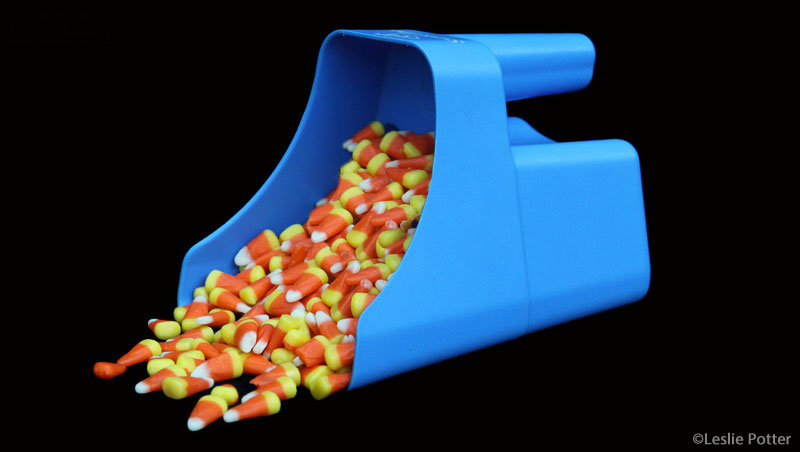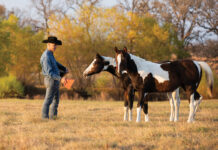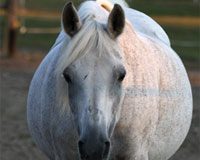
With Halloween happening this week, you’ve undoubtedly got some extra candy in your pantry, sitting in the break room at your office, or maybe even in your tack room. Maybe you’ve thought about sharing the caloric wealth with your equine best friend, but is Halloween candy safe for horses?
Death by Chocolate
“Chocolate contains a chemical called theobromine which is potentially toxic for horses,” says Juliet M. Getty, Ph.D., an independent equine nutritionist and consultant. “The darker the chocolate, the more theobromine it contains. It can affect the central nervous system as well as the heart and kidneys.”
Getty points out that because horses are physically unable to vomit, the potentially toxic effects of chocolate need to be taken very seriously.
“If a dog were to overdose on chocolate, the treatment generally involves inducing vomiting,” says Getty. “For horses, this is not possible, making it especially dangerous.”
Taste the Rainbow
Since you probably wanted to keep that chocolate for yourself anyway, you might be thinking about slipping your horse a few Smarties or some Skittles. Horses love sugar and fruit flavors, so those Halloween candies are sure to be a hit. But proceed with caution.
“Hard candies like peppermints are okay in strict moderation if the horse is able to tolerate small amounts of sugar,” says Getty. “If the horse has equine metabolic syndrome, Cushing’s, or Polysaccharide Storage Myopathy (PSSM), I would not give him candy.”
Getty also recommends against giving horses sticky candies. “I would think that [chewy candies like] gummy bears would be very frustrating for horses because the candy would stick to their molars. I would avoid those,” she says.
Sugar-Free Sweets
With plenty of people cutting back on sugar in their diets, supermarket shelves are stocked with artificially-sweetened, sugar-free alternatives to some popular candies. This may seem like a good option for your horse, but they’re not necessarily any safer than their sugary counterparts.
“There have been studies that suggest that artificial sweeteners can also raise blood insulin levels,” says Getty. “So if you give a sugar-free peppermint to your horse, only give one or two. Don’t think that because they are sugar-free it’s safe to feed more.”
The Fruit of the Fall
There is one iconic Halloween food item that can be fed to most horses, as long as it’s done in moderation instead of candy.
“Pumpkin, as well as other forms of squash, is fine to feed to horses,” says Getty. She adds that the key is to limit the quantity. “Any time a new feed is introduced into the horse’s diet, it should be done gradually, so I do not recommend giving a horse a large amount of pumpkin all at once. A few pieces as a treat are fine, but don’t chop up a whole pumpkin and offer it to your horse—that’s a colic episode waiting to happen.”
If you’re looking to dispose of your Jack-o-Lantern on November 1st, the compost heap is probably a better choice than your horse’s feed bin if that carved pumpkin has been hanging around for a while.
“If the pumpkin is a day old, it may be okay to feed as long as it has been outside in cold weather,” says Getty. “If it has been indoors at room temperature, the bacterial growth may be too high to offer your horse. And be sure to only feed the meat of the pumpkin—not the hard peel. It is very fibrous and therefore digested in the hindgut. Large pieces could be problematic.”
“Pumpkin seeds are also an excellent treat for horses,” adds Getty. “They can be fed raw or roasted, including the shells. Again, feed small amounts—no more than ½ cup per day. If you want to feed pumpkin seeds on a regular basis, you can slowly increase the amount over a period of two to three weeks to avoid digestive upset.”
Click here for a recipe for homemade pumpkin horse treats >>
A little extra Halloween treat is fine for most horses. But as with kids coming home from trick-or-treating with bags full of candy, you’ll want to moderate their consumption to avoid the problems that come from overindulgence.
“Remember that a treat is meant to be offered in very small amounts,” says Getty. “Horse’s digestive systems take time to adjust to new feeds.”
Liked this article? Here are others you’ll love:
Halloween on Horseback
What Flavors do Horses Like Best?
Feeding Fruit to an Insulin-Resistant Horse
Get more nutrition advice from Juliet M. Getty, Ph.D., at GettyEquineNutrition.com.







Great advice.
This was really interesting! Good to know about the chocolates in particular.
Wow, learned something new…I do not feed chocolate to my horses, but I never even knew it was toxic to them.
cool article, pretty common knowledge.
use common sense people
Glad to hear pumpkin rind, not aged or housebound, is ok for the horse’s. They love them and watermellon rind too. Hey, it’s around the house and already paid for. Horse treats, at the stores, can be pricey!
P.S. Waiting (un)patiently for those redeemed horse treats….good thing it’s noted….one per household!
Great advise and thanks for the new ideas.
cool
Just a note on the sugar free stuff, Xylatol is a new sugar free substitute that is FATAL to dogs.
I’ve always found it very concerning to mess with human treats and my horses. I always treat with Charleigh’s Cookies- the ingredients are organic (minus the corn) and delicious. My horses and pony’s are always happy! Especially with the bite size XOXO, delicious and I feel safe feeding them! CharleighsCookies.com
cool
I like to teach my horse tricks using treats. My favorite is small pieces of carrots. But for a special treat I bake a biscuit with molasses that can be cut into tiny pieces. My horses LOVE these: http://www.horsetricks101.com/2014/02/molasses-trick-training-treat/
Jain & Trigger
It’s probably worth pointing out that theobromine is not especially toxic to horses. In one study it took one vending-machine-size bag of peanut M&Ms fed to horses every day for eight days to be detectable in the horses’ systems, and the reason the study was done was to test whether the theobromine and caffeine was *performance enhancing*, not toxic. I’m not advocating feeding your horse chocolate, but if you do, it’s probably not a big deal.